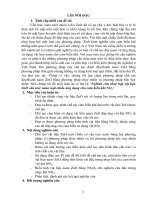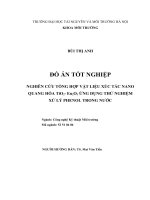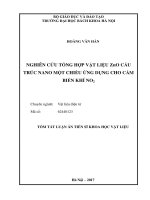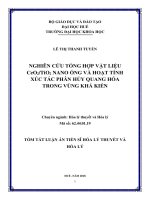Nghiên cứu tổng hợp vật liệu nano mangan oxit, sát oxit trên graphen oxit dạng khử ứng dụng xử lí một số chất màu hữu cơ và hoá chất bảo vệ thực vật trong môi trường nước tt tiếng anh
Bạn đang xem bản rút gọn của tài liệu. Xem và tải ngay bản đầy đủ của tài liệu tại đây (1.68 MB, 28 trang )
MINISTRY OF EDUCATION AND
TRAINING
VIETNAM ACADEMYOF
SCIENCE AND TECHNOLOGY
GRADUATE UNIVERSITY SCIENCE AND TECHNOLOGY
……..….***…………
Nguyen Vu Ngoc Mai
STUDY ON SYNTHESIS OF MANGANESE OXIDE,
IRON OXIDE ON REDUCED GRAPHENE OXIDE
NANOPARTICLES TO TREATMENT OF PIGMENTS
AND PESTICIDES IN THE AQUEOUS ENVIRONMENT
Major: Environmental Engineering
Code: 9 52 03 20
SUMMARY OF ENVIRONMENTAL ENGINEERING
DOCTORAL THESIS
Hanoi – 2020
The thesis was performed at Graduate University of Science and
Technology, Vietnam Academy Science and Technology
Supervisor 1: Assoc. Prof. Dr.Nguyen Quang Trung
Supervisor 2: Assoc. Prof. Dr. Dao Ngoc Nhiem
Reviewer 1: …
Reviewer 2: …
Reviewer 3: ….
The thesis will be defended at the doctoral thesis committee at the
Academy level, meeting at the Graduate University of Science and
Technology - Vietnam Academy of Science and Technology at
………… on………, 20…….
The thesis can be found in:
- The library of Graduate University of Science and Technology
- National Library of Vietnam
NEW FINDINGS OF THE THESIS
1.
Successfully synthesized mixed oxide Fe2O3 – Mn2O3
nanoparticles using tartaric acid (AT), tartaric acid combined with
polyvinyl alcohol (PVA) as gel – forming agents. Nanostructured
Fe2O3-Mn2O3 mixed-oxides prepared by the combustion method that
used a mixture of tartaric acid and PVA (pH 4, the molar ratio of
Fe/Mn = 1/1, the molar ratio of AT/PVA = 1/1, the molar ratio of
(Fe/Mn)/(AT /PVA) = 1/3, the gel-forming temperature of 80 oC and
the calcination temperature at 450 oC during 2h) had uniform size
and specific surface area of their (63.97 m2/g) was larger than using
only tartaric acid as gel – forming agents (46.25 m2/g).
2.
Studied the photocatalytic ability of Fe2O3 –Mn2O3 and
Fe2O3 –Mn2O3/rGO materials to decompose some pollutants such as
methyl orange , methylene blue, parathion, fenitrothion. For the first
time, mixed oxide Fe2O3 – Mn2O3/rGO nanoparticles were studied to
decompose parathion and fenitrothion. The results showed that
parathion was decomposed efficiency (after 90 minutes reaction
time, pH 7.5, the concentration after adsorption equilibrium is 1.5
ppm, the catalyst content of 0.05 g/L, the decomposition efficiency
of parathion is 77.32%). The decomposition efficiency fenitrothion
(after 90 minutes reaction time, pH 7.0, concentration after
adsorption equilibrium 1.4 ppm, catalyst content of 0.05 g/L) is
88.61%. Through modern analytical methods such as Highperformance liquid chromatography and Gas chromatography- mass
spectrometry, some intermediates formed during the decomposition
of methyl orange, methylene blue, parathion, fenitrothion are
proposed.
LIST OF WORKS HAS BEEN PUBLISHED
1. Nguyen Vu Ngoc Mai, Dao Ngoc Nhiem, Pham Ngoc
Chuc, Nguyen Quang Trung, Cao Van Hoàng, Synthesis of Fe2O3Mn2O3 nanostructured by tartaric acidand preliminary study on
methylene orange degradations, Vietnam Journal of Chemistry
(2017), 55 (3e12).
2. Nguyen Vu Ngoc Mai, Nguyen Thi Ha Chi, Nguyen
Quang Bac, Doan Trung Dung, Pham Ngoc Chuc, Duong Thi Lim,
Nguyen Quang Trung, Dao Ngoc Nhiem, Synsthesis of nano – mixed
oxides Fe2O3 - Mn2O3 and their applications to photocatalytic
degradation of Parathion from water, Proceedings The 3rd
International Workshop on Corrosion and Protection of Materials
(2018), Hanoi, Vietnam.
3. Nguyen Vu Ngoc Mai, Duong Thi Lim, Nguyen Quang
Bac, Nguyen Thi Ha Chi, Doan Trung Dung, Ngo Nghia Pham, Dao
Ngoc Nhiem, Fe2O3/Mn2O3 nanoparticles: Preparations and
applications in the photocatalytic degradation of phenol and
parathion in water, Journal of the Chinese chemical society (2019),
DOI : 10.1002/jccs.201900033
4. Nguyen Vu Ngoc Mai, Doan Trung Dung, Duong Thi
Lim, Dao Ngoc Nhiem, Study on synthesis of Mn3O4 nanoparticles
and their photocatalytic ability, Vietnam Analytical Sciences Society
(2019), 1, 24.
5. Nguyen Vu Ngoc Mai, Nguyen Thi Ha Chi, Duong Thi
Lim, Nguyen Quang Trung, Dao Ngoc Nhiem, Study on
photodegradation of methyl orange, dimethoate and parathion from
aqueous solution by nano iron – manganese oxide particles, Vietnam
Journal of Chemistry (2019), 57(4e1,2) 330-334.
6. Nguyen Vu Ngoc Mai, Doan Trung Dung, Nguyen
Quang Bac, Duong Thi Lim, Nguyen Quang Trung, Dao Ngoc
Nhiem, Synthesis of nano-mixed oxides Fe2O3-Mn2O3 and their
applications in phenol treatment, Vietnam Journal of Chemistry
(2019), 57(4e1,2) 330-334.
1
INTRODUCTION
The urgency of the thesis
Currently, environmental pollution is a great challenge to the globe
including Vietnam. Industrialization and modernization of the
economy are raised many persistent pollutants such as pigments,
phenol, antibiotics, …becoming more and more.
Viet Nam is a long-standing agricultural country. To meet the food
needs of the increasing number of people, the cultivated area is
increasingly shrinking, measures such as agricultural intensification,
seed improvement, the use of crop pesticides are implemented to
increase productivity. Organophosphorus with the advantage of a
wide range of prevention and rapid elimination of pests and diseases
are now widely applied. However, the widespread use of
organophosphorus during cultivation has left this chemical residue in
the environment very large, especially in the aqueous environment.
Thus, not only in industrial wastewater but also in agricultural
wastewater, durable and persistent organic substances should be
treated. Currently, many studies focus on completely mineralizing
these persistent pollutants into non-toxic substances. The advanced
oxidation method based on hydroxyl radical activity ●OH (with the
highest oxidation potential of 2.8 eV) is of interest to study on. The
formation of ●OH radicals during reaction occurs through a variety of
processes, including photocatalytic processes based on mixed oxide
Fe2O3 – MnOx nanoparticles. The efficiency of the photocatalytic
process increases with the dispersion of these nanoparticles on the
carrier (rGO). The object selected for treatment is persistent organic
pigments, including MO, MB, and pesticides which are represented
2
by fenitrothion and parathion. The photocatalytic process is applied
to treat these pollutants. From the above reasons, the topic “ Study on
synthesis of manganese oxide, iron oxide on reduced graphene oxide
nanoparticles to treatment of pigments and pesticides in the aqueous
environment” is selected to research and deal with these pollutants in
Vietnam.
The objectives of the thesis
Successfully synthesized nano – mixed oxide by different gelling
agents; compared, selected the appropriate gelling agent; researched
to evaluate the catalytic activity of mixed oxide nanoparticles formed
with pollutants methyl orange (MO), methylene blue (MB).
Successful dispersed mixed oxide nanoparticles on rGO; investigated
catalytic activity of material systems on parathion, fenitrothion.
The main contents of the thesis
- Synthesis of metal oxide nanomaterials by a gel - forming agent as
tartaric acid and a combination of tartaric acid and PVA, thereby
comparing and selecting the appropriate gel - forming agent.
- Evaluation of the photocatalytic ability of system Fe2O3 – Mn2O3
in decomposition process MO and MB of the synthesized material
system.
- Dispersion of mixed oxide nanoparticles Fe2O3 – Mn2O3 on a
carrier rGO. Survey to evaluate the photocatalytic ability of material
system Fe2O3 – Mn2O3/rGO in the process of decomposition
parathion and fenitrothion.
- Evaluation of the reusability of the catalyst.
3
Chapter 1. OVERVIEW
1.1. General introduction about pesticides
1.1.1. Definitions of pesticides
Pesticides which are substances or mixtures work to:
prevent, stop, repel, induce, destroy or control crop pests;
regulate crop or insect growth;
preserve crops; increase safety and effectiveness when using
the pesticides.
1.1.2. Classification of pesticides: four main groups
1.1.2.1. Organochlorines
1.1.2.2. Organophosphorus: is the ester of phosphoric acid and its
derivatives [7].
1.1.2.3. Carbamates
1.1.2.4. Pyrethroids
1.1.3. Current situation of pesticide use in Vietnam
How to use pesticides in our country today
Using pesticides which has been banned
Increasing using dosage
Spraying pesticides at anytime
Using the wrong manual
Organophosphorus are more durable than those in the pyrethroids
group. Carbamates have a fairly common use rate in many
agricultural areas. Organochlorines are mostly banned from use.
1.1.4. Negative effects of organophosphorus pesticides
1.1.4.1. Soil pollution
1.1.4.2. Air pollution
1.1.4.3. Water polution
4
In the Northern of Viet Nam [16], fenitrothion (0,06 và 0,04
mg/L), dichlorvos (0,02 and 0,03 mg/L) were detected.
In groundwater: dichlorvos was found in 45% of all samples
taken, fenitrothion was found in all samples [16].
In the Mekong Delta, in 2008, Carvalho and etc. [17]
showed that concentration of diazinon was 3,5 – 42,8 ng/L, that of
fenitrothion was 3,3 – 11,9 ng/L found in 5/8 samples.
Organophosphorus pesticides residues were detected in soil, air,
surface water, and groundwater. The commonly used peticides are
fenitrothion, diazinon, quinalphos, dichlorvos. Comparing with
Limited standard EC, residues concentration of pesticides exceeds
the allowed level (0.5 µg/L).
1.1.4.4. Impact on human, plants and animals
In addition to the environment pollution by pesticide residues, the
pollution by pigments should also be treated. These substances are
very toxic and dangerous to human health and the ecosystem [19,
20]. In the thesis, MO, MB which are the pigments and pesticides
which are parathion, fenitrothion are selected to research and
treatment with these pollutants in Vietnam.
1.2. General introduction about some research pollutants
1.2.1. Physical and chemical properties of some organic pigments
Hình
Figure 1.2. The molecular
Figure 1.3. The molecular
structure of MO
structure of MB
5
Figure 1.4. The molecular
structure of parathion
Figure 1.5. The molecular
structure of fenitrothion
1.3. Methods for treating pigments and organophosphorus in
agricultural wastewater
1.3.1. The adsorption method
The main disadvantage of this method is that the adsorbent must be
reconstituted, and the hazardous solid waste which is a saturated
adsorbent containing the high concentrations of pollutants after
treatment must be generated.
1.3.2. The biological treatment methods
The drawbacks of the method are research local available
microorganism, long decomposition time, low decomposition
efficiency.
1.3.3. Decomposes by oxidizing agents
Using strong oxidizing agents to oxidize persistent organic
compounds in wastewater are applied.
1.3.4. The advanced oxidation process
The advanced oxidation process decomposes organic pigments and
pesticides by producing hydroxyl radicals with the highest oxidative
potential (2.8 eV) during the reaction.
1.4. The photocatalysis decomposes organic pigments and
organophosphorus
1.4.1. Introduction to photocatalysis
6
Figure 1.6. Schematic representation of semiconductor
photocatalytic mechanism
1.4.2. Introduction to Fe2O3 – Mn2O3 materials
Mixed oxide Fe2O3 – Mn2O3 nanoparticles are mainly used for
decomposing colored pollutants and high treatment efficiency. The
pesticides that belong to the organophosphorus group, namely
parathion and fenitrothion have not been studied for decomposition
by photochemical processes using this catalyst.
rGO that has a multilayered structure has many functional groups in
its molecule, so it is easy to form bonds with transition metal ions.
With the above advantages, rGO is suitable for dispersing metal
oxide Fe2O3 – Mn2O3 nanoparticles.
1.4.3. The situation of researching on the treatment of pigments
and organophosphorus in Vietnam
Studies to treat organic pigments such as MO and MB have been
widely conducted in Vietnam. Many methods are applied such as
adsorption, coagulation and flocculation,biodegradation,…especially
advanced oxidation processes, including photocatalytic processes.
7
In Vietnam, research on treating residues of organophosphorus is
limited, the main subjects of study are organochlorines such as DDT,
Dioxin. Studies of decomposition by biological, physical, and
chemical methods have also been conducted. However, in Vietnam,
there have been no specific studies on the decomposition of
pesticides, including organophosphorus, particularly parathion and
fenitrothion using a photochemical process with a catalyst of mixed
oxide Fe2O3 – Mn2O3 nanoparticles.
1.5. Methods of synthesizing Fe2O3 - Mn2O3 materials
1.51. Hydrothemal method
1.5.2. Co - precipitation
1.5.3. Sol gel method
1.5.4. Combustion method
The combination of organic acids and PVA as a gel - forming agent
help metal ions easily formed complexes of the metal ion with gel forming agents which are organic acids. These complexes which are
disperse evenly in polymers help to prevent phase separation. The
combination of PVA and organic acids increases the process of
complex creation, the metal complexes are evenly distributed in the
polymer network of PVA, reduced the calcination temperature
needed for the synthesis of mixed oxide Fe2O3 – Mn2O3
nanoparticles.
8
Chapter 2. EXPERIMENT
2.1. Materials
2.2. Synthesis of materials
2.2.1. Methods of synthesis of mixed oxide Fe2O3 – Mn2O3
nanoparticles (Figure 2.1)
2.2.2. Methods of synthesis of mixed oxide Fe2O3 – Mn2O3/rGO
nanoparticles (Figure 2.2)
Gelforming
agents
solution
Fe2+
solution
and Mn2+
solution
Gelforming
agents
solution
String, heating
Mixture
solution
Viscous
gel
Fe2O3Mn2O3
Dry
gel
adjust pH
calcinating
Figure 2.1. Diagram of Fe2O3-Mn2O3 synthesis process using
combustion method
String, heating
Mixture
solution
Fe2+
solution
and Mn2+
solution
Drying at 110 oC for 2h
rGO
Visco
us gel
/rGO
Visc
ous
gel
adjust pH
string
Fe2O3Mn2O3
/rGO
heating, calcinating
Figure 2.2. Diagram of Fe2O3-Mn2O3/rGO synthesis process
using combustion method
9
2.3. Characterization of materials
2.3.1. Thermal Analysis method (TGA - DTA)
2.3.2. X – ray diffraction method (XRD)
2.3.3. Energy-dispersive X-ray spectroscopy method (EDS)
2.3.4.Scanning
Electron
Microscope
Method
(SEM)
and
Transmission Electron Microscope Method (TEM)
2.3.5. Brunauer-Emmet-Teller Method (BET)
2.3.6.The
method
of
determining the point of zero
charge of materials
2.4. Catalyst activity testing
Figure 2.3. Equipment of Ace
Photochemical UV Power Supply &
Mercury Vapor Lamps (USA)
V: 500 mL
Lamp Watts: 450W, 135 V, Arc –
length:11,4 cm, lamp is the use of
a light source to simulate sunlight
2.4.1. Decomposion efficiency of MO, MB of photocatalyst mixture
material by Fe2O3 – Mn2O3 nanoparticles
The photodegradation efficiency of each sample was calculated by
the following expression:
H % =
C0 − Cf
∗ 100%
C0
2.3
2.4.2. Test of (Fe2O3 – Mn2O3)/rGO on pesticides treatment
10
2.4.2.1. Equilibrium adsorption process of pesticides
2.4.2.2. Effect of reaction time on the degradation of pesticides
2.4.2.3. Effect of catalyst dosage on the degradation of pesticides
2.4.2.4. Effect of pH on the degradation of pesticides
2.4.2.5. Effect of inital pesticides concentration
2.5. The methods used to analyze pollutants in the study
2.5.1. The photometric method was determined the content of MO
and MB in the sample
2.5.2.The
liquid
chromatographic
method
was
identified
intermediates formed during the decomposition of MO and MB
2.5.3.The GC/MS method was determined the concentrations of
parathion and fenitrothion in the sample
Chapter 3. RESULTS
3.1. Study on synthesizing nano mixed oxide Fe2O3 - Mn2O3
particles
3.1.1. Study on synthesizing nano mixed oxide Fe2O3 – Mn2O3
particles with tartaric acid as gel – forming agents
3.1.1.1. TGA – DTA analysis of pre - sample with tartaric acid as gel
– forming agents (Figure 3.1)
3.1.1.2. The effect of calcination temperature on the formation of
Fe2O3 - Mn2O3 phase (Figure 3.2)
3.1.1.3. The effect of pH on the formation of Fe2O3 - Mn2O3 phase
(Figure 3.3)
3.1.1.4. The effect of Fe/Mn mole ratio on the formation of Fe2O3 Mn2O3 phase (Figure 3.4)
3.1.1.5. The effect of gel-forming temperature on the formation of
Fe2O3 - Mn2O3 phase (Figure 3.5)
11
Figure 3.2. X-Ray diffractions at
various calcination temperatures a)
300 oC, b) 400 oC, c) 450 oC, d)
500 oC, e) 550 oC, f) 600 oC
o
→ The optimum temperature (500 C) was chosen
Figure 3.1. TGA and DTA
curves of the as prepared gel
Figure
3.3.
X-Ray
diffractions at various pH
a) pH 1, b) pH 2, c) pH 3,
d) pH 4, e) pH 5
→ The pH value chosen was pH 4
Figure
3.4.
X-ray
diffraction of samples with
various
mole
ratios
of
Fe/Mn a) 9/1; b) 3/1; c) 2/1;
d) 1/1; e) 1/3; f) 1/9
→ The Fe/Mn mole ratio chosen was Fe/Mn = 1/1
12
Figure
3.5.
X-ray
diffraction of samples at
various gel temperatures
a) 40 oC; b) 50 oC; c) 60
o
C; d) 80 oC; e) 100 oC
→ The gel-forming temperature was chosen at 80 oC
3.1.2. Study on synthesizing nano mixed oxide Fe2O3 – Mn2O3
particles with tartaric acid combined with PVA as gel – forming
agents
3.1.2.1. TGA – DTA analysis of pre - sample with tartaric acid
combined with PVA as gel – forming agents (Figure 3.6)
Figure 3.6. TGA and
DTA curves of the as
- prepared gel
(Fe-Mn)/ (AT+PVA)
3.1.2.2. The effect of calcination temperature on the formation of
Fe2O3 - Mn2O3 phase (Figure 3.7)
Figure
diffractions
3.7.
at
X-Ray
various
calcination temperatures: a)
300oC, b) 400oC, c) 450oC,
d)500oC, e) 550oC và f) 600oC
13
→ The optimum temperature (450 oC) was chosen
3.1.2.3. The effect of pH on the formation of Fe2O3 – Mn2O3 phase
Figure
3.8.
X-Ray
diffractions at various
pH: a) pH 1, b) pH 2,
c) pH 3, d) pH 4
→ The pH = 4 was chosen.
3.1.2.4. The effect of Fe/Mn mole ratio on the formation of Fe2O3 –
Mn2O3 phase
Figure 3.9. X-ray diffraction
of samples with various
mole ratios of Fe/Mn: a)
Fe/Mn = 6/1, b) Fe/Mn =
3/1, c) Fe/Mn = 1/1, d)
Fe/Mn = 1/3, e) Fe/Mn = 1/6
→ The Fe/Mn mole ratio chosen was Fe/Mn = 1/1
3.1.2.5. The effect of AT/PVA mole ratio on the formation of Fe2O3 Mn2O3 phase
Figure 3.11. X-ray diffraction
of samples with various mole
ratios of AT/PVA: a) AT/PVA
= 6/1, b) AT/PVA = 3/1, c)
AT/PVA = 1/1, d) AT/PVA =
1/3, e) AT/PVA = 1/6
→ The AT/PVA mole ratio chosen was AT/PVA = 1/1
14
3.1.2.6. The effect of gel-forming temperature on the formation of
Fe2O3 - Mn2O3 phase
Figure
3.12.
X-ray
diffraction of samples at
various gel temperatures:
a) 40 oC, b) 60 oC, c) 80
o
C, d) 100 oC
→ The gel-forming temperature was chosen at 80 oC
3.2. Compare and select gel – forming agents to synthesize mixed
oxide Fe2O3 – Mn2O3 nanoparticles
Table 3.8. The results of samples with different gel-forming agents
Gel-forming
Calcination
BET (m2/g)
References
o
agents
temperature ( C)
PVA
550
68.5
[118]
AT
500
46.25
This research
PVA + AT
450
63.97
This research
a)
b)
Figure 3.15, Figure 3.16. TEM images of Fe2O3 – Mn2O3 samples
a) using tartaric acid b) using AT+PVA
15
The synthesized mixed oxide Fe2O3 – Mn2O3 nanoparticles had a
spherical shape, the nanoparticle size synthesized by gel AT agent
combined with PVA is smaller and has a higher uniformity than
those by the only agent as AT. Moreover, the material surface was
more porous, the specific surface area is bigger, increasing the
adsorption capacity, creating more favorable conditions for the
photocatalytic process to decompose pollutants later.
→ The gel – forming agent which was AT + PVA was chosen to
synthesize mixed oxide Fe2O3 – Mn2O3 nanoparticles
To further clarify the formation of mixed oxide Fe2O3 – Mn2O3,
mixtures of AT and PVA were applid to synthesize metal oxide
singles of iron and manganese under conditions suitable for gelforming agents.
Table 3.6. Characteristics of the synthesized materials using AT +
PVA
Materials
Morphology
BET (m2/g)
Vpore
Pore size
3
(cm /g)
(nm)
Fe2O3
Stick
18.313
0.071
19.962
Mn2O3
Sphere
9.169
0.003
18.195
Fe2O3 - Mn2O3
Sphere
63.971
0.103
10.939
Figure 3.17. FE – SEM
images of Fe2O3, Mn2O3,
Fe2O3 – Mn2O3
16
The mixed oxide nanoparticles were porous, small in size, uniform
with a specific surface area many times larger than the synthetic
single oxide nano (these properties are not available in the case of
mixtures of two oxides Fe2O3 and Mn2O3).
3.3. Photocatalytic degradation of MO, MB by synthesized
catalysts of mixtures of AT and PVA using gel – forming agents
3.3.1. Photocatalytic degradation of MO by Fe2O3, Mn2O3, Fe2O3 –
Mn2O3
The formation of intermediates in a convenient way for the
decomposition process to produce the final product as CO2 , H2O
continued these intermediates [120, 121].
Figure
3.19.
decomposition
MO
using
various materials
Figure 3.24. MO
decomposition
pathway
using
Fe2O3 – Mn2O3
catalyst
17
3.3.2. Photocatalytic degradation of MB by Fe2O3, Mn2O3, Fe2O3 –
Mn2O3
Figure
3.25.
MB
decomposition
using
various materials
Figure 3.31. MB decomposition
pathway using Fe2O3 – Mn2O3
catalyst
3.4. Synthesis of Fe2O3-Mn2O3/rGO material
Figure 3.32. X-ray
diffraction
of
samples: a) rGO, b)
Fe2O3-Mn2O3,
c)
Fe2O3-Mn2O3 /rGO
18
Results of XRD of the Fe2O3-Mn2O3 /rGO sample appear typical
peaks of rGO, Fe2O3-Mn2O3
Table3.13. Structural parameters of synthesized materials
Materials
BET (m2/g)
Vpore (cm3/g)
Pore size (nm)
rGO
200.682
0.352
8.789
Fe –Mn
63.972
0.103
10.939
Fe –Mn/rGO
131.984
0.418
14.422
.
Figure 3.35. FE – SEM
images of rGO, Fe2O3 –
Mn2O3, Fe2O3 – Mn2O3/rGO
There was a connection between metal ions into rGO layers. The
increased hole size, pore size created more activity centers on the
material surface than those on the original Fe2O3-Mn2O3, rGO
materials.
3.5. Effects of parameters on the degradation of fenitrothion and
parathion using Fe2O3-Mn2O3/rGO photocatalytic material
3.5.1. Effects of parameters on the degradation of parathion
3.5.1.1. Equilibrium adsorption process of parathion
3.5.1.2. Effect of reaction time on the degradation of parathion
3.5.1.3. Effect of catalyst dosage on the degradation of parathion
3.5.1.4. Effect of pH on the degradation of parathion
3.5.1.5. Effect of inital parathion concentration
3.5.1.6. Proposed oxidative degradation route of parathion
19
Figure 3.37.
Figure 3.38.
Parathion adsorption ability
Parathion decomposition ability
using Fe2O3 – Mn2O3/rGO in
using Fe2O3-Mn2O3 /rGO at
the dark for 24h
Figure
3.39.
Parathion
decomposition
ability
using
Fe2O3-Mn2O3/rGO at various
catalyst content a) 0,05 g/L; b)
0,025 g/L; c) 0,01 g/L; d) 0,1 g/L
Figure 3.42. Parathion removal
efficiency on Fe2O3-Mn2O3 /rGO
catalyst at different catalyst initial
parathion concentrations a) 1,5
ppm; b) 5 ppm; c) 10 ppm
various reaction times
Figure
3.40.
Parathion
decomposition ability using Fe2O3Mn2O3/rGO at various pH
20
Figure 3.46. Parathion
decomposition pathway
using Fe2O3-Mn2O3/rGO
nanocomposite catalyst
3.5.2. Effects of parameters on the degradation of fenitrothion
3.5.2.1. Equilibrium adsorption process of fenitrothion
3.5.2.2. Effect of reaction time on the degradation of fenitrothion
3.5.2.3. Effect of catalyst dosage on the degradation of fenitrothion
3.5.2.4. Effect of pH on the degradation of fenitrothion
3.5.2.5. Effect of inital fenitrothion concentration
3.5.2.6. Proposed oxidative degradation route of fenitrothion
21
Figure 3.47.
Figure 3.48.
Fenitrothion adsorption ability
Fenitrothion decomposition ability
using Fe2O3 – Mn2O3/rGO in
using Fe2O3-Mn2O3 /rGO at
various reaction times
the dark for 24h
Figure
3.49.
Fenitrothion
decomposition
ability
using
Fe2O3-Mn2O3/rGO at various
catalyst content a. 0,01 g/L; b.
0,025 g/L; c. 0,05 g/L; d. 0,1 g/L
Figure 3.51. Fenitrothion removal
efficiency on Fe2O3-Mn2O3 /rGO
catalyst at different catalyst initial
parathion concentrations a) 1,4
ppm; b) 5 ppm; c) 11 ppm
Figure
3.50.
Fenitrothion
decomposition ability using Fe2O3Mn2O3/rGO at various pH









